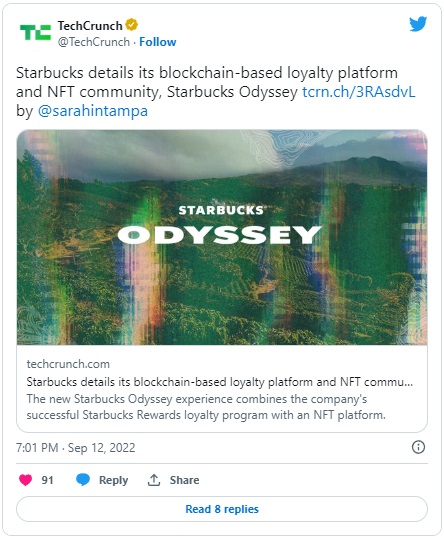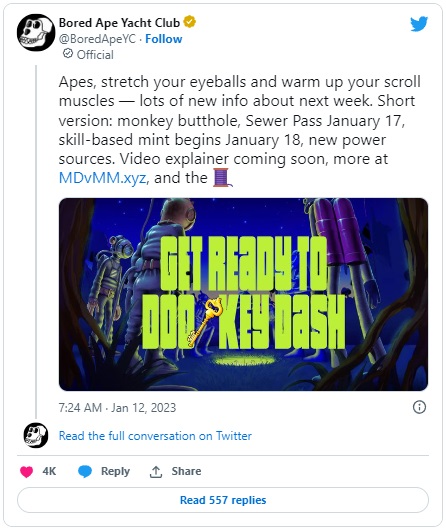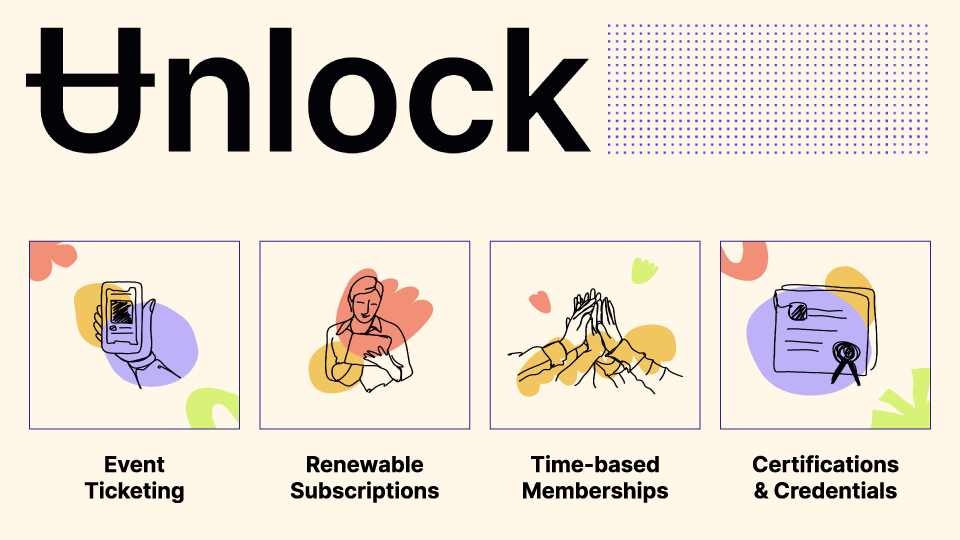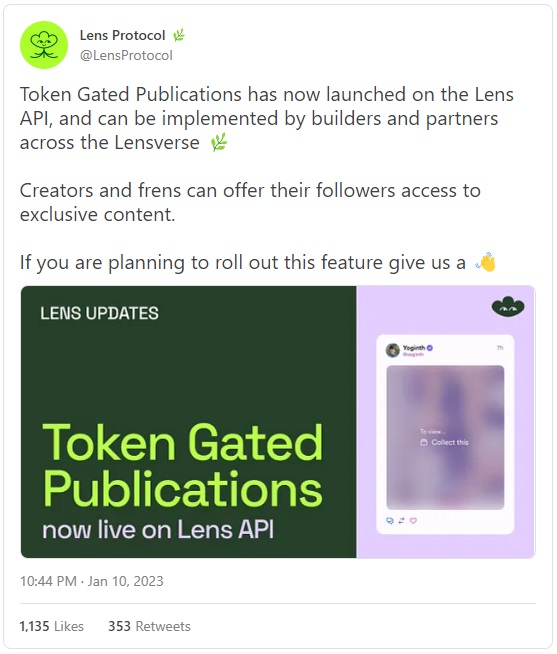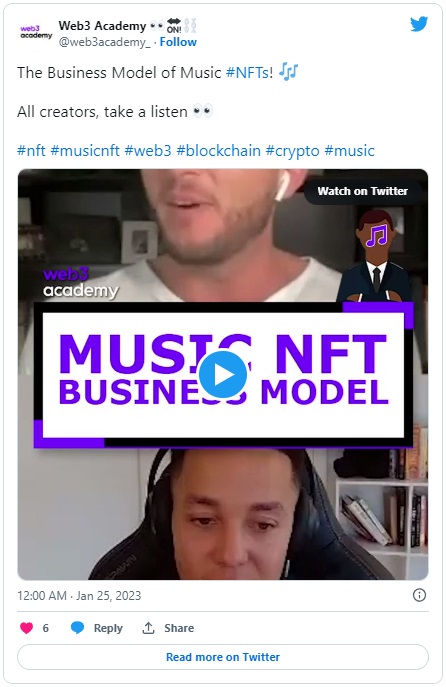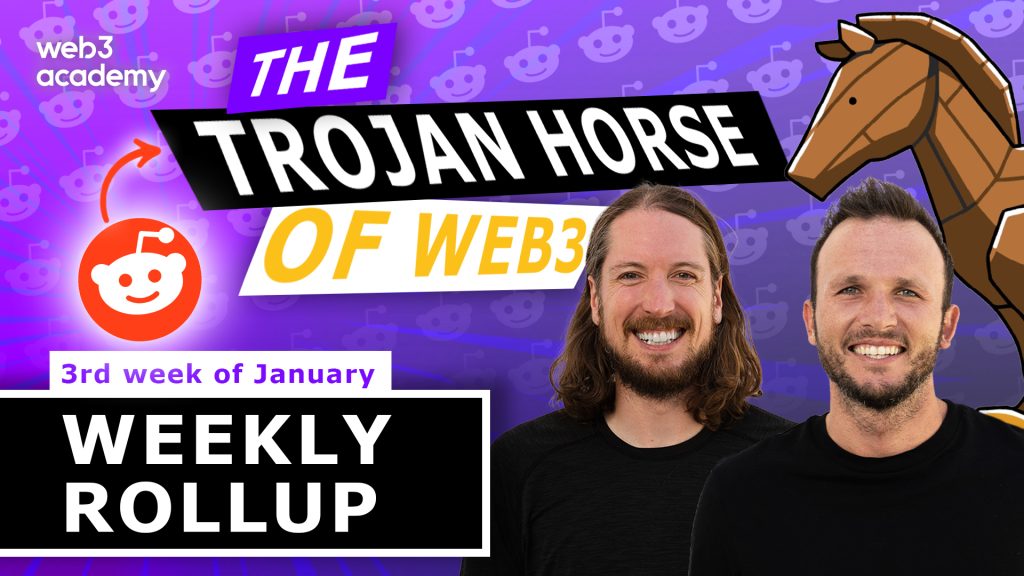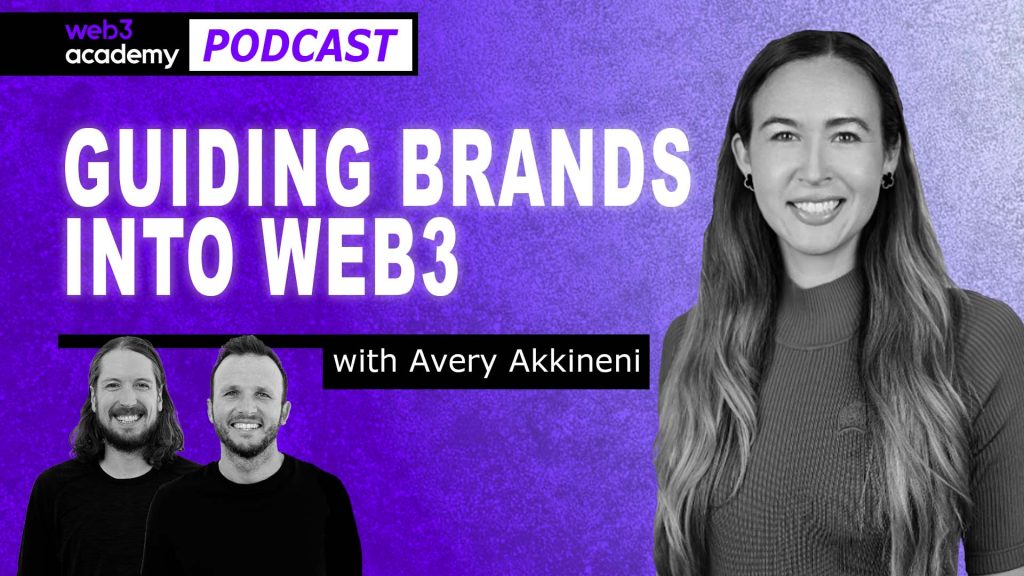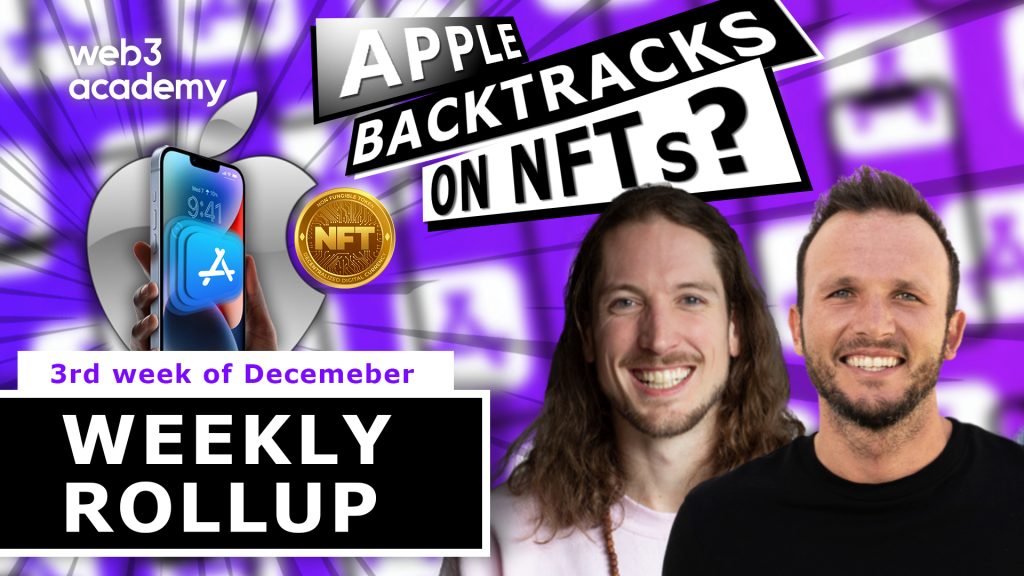
6 Web3 Concepts Businesses & Creators Must Plan For in 2023 | Amanda Cassatt from Serotonin
A new marketing paradigm is coming
Prefer listening? Learn about these 6 web3 concepts on your favorite platform 👇
GM Doers!
There’s always so much innovation and experimentation happening in web3 that it can be next to impossible to keep up.
But when we zoom out and look at the big picture, there are just six main web3 concepts that builders and creators must focus on in 2023. 💭
To help explain these concepts, we invited Amanda Cassatt, the person who brought Ethereum to market as the CMO of ConsenSys and is now the founder and CEO of web3’s leading marketing agency, Serotonin.
Here’s what we’re breaking down today:
- NFTs and their future adoption 📈
- Communities and the role they play in web3 🧑🏻🤝🧑🏻
- How marketing is changing in the space 🗣️
- Web3 social and the creator economy 🧑🎨
- Metaverse experimentation and adoption 🧑💻
- DAOs and their implementation 🛠️
Let’s dive in.
The Future Adoption of NFTs
We always say NFTs are just technology. They’re just a wrapper, a vehicle, not the end result. In fact, Amanda likes to call them a substrate that people can mold to fit their needs, and we couldn’t agree more.
Now that the speculative mania of 2021 is over, we’re starting to see more NFTs used for real utility outside of art and digital collectibles. 💪
One of the use cases that’s growing in popularity right now is membership and loyalty programs.
We saw Starbucks recently launch the beta test of their web3 rewards program—which we think will be one of the biggest onboarding ramps of 2023 if they get out of beta that is.
But why put loyalty points on-chain?
Right now, loyalty programs are pretty bland. They give you points based on how much you spend which you can redeem for vouchers, items, discounts, etc. and that’s it.
But if we use web3 technology, it unlocks so much more. Businesses can now also offer members digital items and experiences which are not only low-cost for the company, but also give users more options.
On top of this, it can also allow participants to easily sell their points since NFTs (or fungible tokens) can be exchanged peer-to-peer or through a marketplace. This is a huge unlock for people who never use their points.
I mean, have you seen the “rewards” that some companies offer? 🤮
On that note, being able to freely sell loyalty points or memberships is one of the biggest benefits of using NFTs for both consumers and businesses.
From a consumer perspective, they’ll become more open to spending larger amounts of money on memberships because they’re able to recoup at least some of the money they spend.
For example, BAYC recently dropped an NFT collection called Sewer Passes which is a ticket to participate in a play-to-win activation. If I wanted to participate, I could have bought a bored ape (aka my community membership), claimed my free Sewer Pass, and then sold my ape again.
The same could be done with the thousands of exclusive, expensive memberships currently available if they went on-chain.
Putting loyalty programs and memberships on-chain also means companies must prepare for the subsequent restrictions on storing identity data.
Companies will still have wallet addresses through which they can track buying behavior, but, unlike using ad platform data, it won’t be tied to an identity.
But even though companies won’t have access to in-depth user data, they will have access to thousands of additional data points that they otherwise wouldn’t have.
This is because anyone can view a wallet’s transaction history, meaning you could “spy” on how your community (or potential customers) interacts with your competitors or even target your competitors’ customers with marketing activations.
And since this data will be accessible for as long as the blockchain it’s stored on exists, you’ll be able to retarget their existing customers in perpetuity.
On top of this, since data is stored on-chain, you won’t have to store all this data yourself, making it easier to manage, more accurate, and making your company less vulnerable to hacks. 🔒
It also means that you can freely revamp legacy computer systems without losing valuable customer data.
Note: We’re breaking down everything happening with Music NFTs in tomorrow’s PRO report. So if understanding NFT adoption is important to you, make sure you go PRO today.
Communities and Their Role in Web3
Community is a word we all tend to throw around a lot in web3. Some people think it’s simply a buzzword, but Amanda believes it references something very specific—the melding of the investor, user, and team into one aligned category, community.
But why focus on community rather than building as a web2 company would? 🤔
In web2, consumers are at arm’s length from your business. But by building with a web3 mindset, you can bring your audience into your development process, ultimately helping you create better products and experiences.
Engaged communities can also function as part-time employees, helping you scale your company with minimal extra overhead.

For example, you can lean on your community to support your marketing efforts, audit your smart contract code, or simply ask them for feedback. Sometimes this happens organically as people interact with your project, but it doesn’t hurt to have a plan for encouraging community input.
👉 If you want to dive deep into the power of community in web3, check out: Why Community Is The Secret to Success.
This is an extremely different approach compared to the traditional web2 strategy of arbitraging CAC (Customer Acquisition Cost) against LTV (Lifetime Value) through a third-party platform.
In web2, the traffic disappears as soon as you stop paying for it. But with a community-first approach, your business can continue growing because of web3 tech’s power to align long-term stakeholder incentives.
The key, though, is to build your community in a sustainable manner and that means no big airdrops!
Here’s how:
At Serotonin, Amanda and her team like to think about community-building as a group of aliens on a spaceship (your company or project) that are visiting Earth. Once they arrive, they drop a ladder wherever they land and invite some humans (your community) onboard.
The only problem now is that the aliens and humans are stuck together indefinitely!
So you want to be extremely careful about where you land your “ship” and who you let into your community in its early stages because this will set the tone going forward.
If you need people who are motivated to help you build, you need people who believe in your vision, not people that are looking to make a quick buck from an airdrop or a whitelist mint.

For example, if you’re building an NFT project, you could look for early members who are interested in the tokens’ art style or the artist themselves.
This is vital because eventually, the community will scale beyond what you can handle alone, so it needs sturdy foundations to sustain itself.
But where should you host your community’s home base?
Right now, there’s one platform that’s a cut above the rest and that’s Discord. 🏅
Besides the fact that many early crypto and web3 adopters were already using the platform because of their background, Discord integrated web3 functionality (such as token gating) much earlier than other platforms.
This combination made Discord the go-to community platform for everyone in the industry. However, Amanda does see a lot of communities on Telegram as well as several new web3-native communication platforms currently being built.
So only time will tell whether Discord stays the de-facto web3 home base for most projects in the future, but right now it’s one of the best options we have.
You can learn more about why and how to build an effective project server from a recent DOer Spotlight with Peter the Discord Guru: Why Discord is the Future of Online Communities.
🤝 Together with Unlock Protocol: Our go-to tool for creating NFT memberships and on-chain event ticketing!⚡
NFT memberships and on-chain ticketing are the future for creators, businesses, and builders in web3.
But implementing this nascent technology isn’t without its hurdles.
Join Unlock’s Discord and learn how to launch tokenized memberships, event tickets, certifications, and more to supercharge your community engagement.
By the way: Everyone in the server is super friendly so don’t be afraid to ask questions!
Why Marketing is Changing in Web3
Thanks to her experience as the CMO of ConsenSys and now the founder and CEO of the leading web3 marketing agency and product studio, it’s safe to say Amanda knows a thing or two about marketing in this space.
Here’s how she thinks about web3 marketing:
Web3 is changing the way we build our marketing systems. In web2, for example, marketing is a bunch of activities done by a centralized marketing function, such as paying other centralized platforms (i.e Facebook) to serve ads to potential customers.
In contrast, web3 allows us to design a self-marketing system. So even before you’ve built any community, even before you’ve decided on your name, it’s about designing a system of incentives using web3 tools.
This system is what’s going to get people extrinsically and intrinsically motivated to help you build your project over the long run.
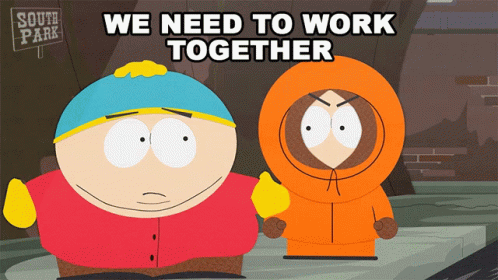
To reiterate, airdrops should not be the main component of your web3 marketing system. As in web2, you must find product-market fit. You want to be able to clearly define why your product is beneficial and share that knowledge with the right people.
You must understand what problem you’re solving, who needs the problem solved, and how much they’re willing to pay to solve it. Without this knowledge, using web3 technology is just a short-term marketing gimmick.
Tokens are not the product of the business, they’re simply a tool that helps you amplify your product or business.
They can help you provide more utility to your product or business, but they are not the product itself. ❌
Now, if web3 marketing fascinates you, Amanda actually has a book coming out on the 4th of April titled Web3 Marketing: A Handbook for the Next Internet Revolution which you can pre-order on Amazon right now.
The book is an excellent resource for all non-technical professionals that are looking to break into web3 whether as an employee, freelancer, or entrepreneur. It teaches you the basics, such as the different types of tokens in web3, what DAOs are, and much more.
It also breaks down the shift to community-focused marketing and the processes that marketers should follow to build their community flywheel.
Plus, there’s a unique claim code inside every book which gets you an NFT with which you can access the content and mentorship within the Web3 Marketing Discord community.
So don’t miss it! 👀

QUESTION
Do You Think Community-First Marketing Will Become the Norm in the Future?
- Absolutely
- Nah
- I think we need a combination of web2 and web3 strategies to succeed
👉 Let us know by leaving a comment below or replying by email!
The Creator Economy and Web3 Social
One of the biggest unlocks of web3 is that it gives creators and users power and ownership over their online identities.
Instead of Facebook or Twitter owning your content, reputation, and audience, you’ll be able to port them between platforms thanks to on-chain social graphs like Lens Protocol.
Amanda believes that 2023 may very well be the year of web3 social because if analysts are correct, crypto prices will likely be flat for most of 2023. Remember, just because we’re experiencing some bullish action now, it doesn’t mean the bull market is back!
So if markets are flat, it means there’s less interest in speculating which means people have more time to experiment with web3 social and build their new online identity. 🏗️
But it’s also important to note that we’re still refining the UX of these platforms. Lens and other protocols and dapps still have tons of new features to ship and bugs to fix before they open themselves to the public.
Amanda thinks that we’re going to see platforms with small dedicated communities come out on top because they have consistent engagement that they can use to grow the platform organically.
But once we have those thriving niche communities, what onboards the masses? 🤔
For creators, it comes down to realizing they don’t have control over their community and content—aka, their business—and moving to greener pastures.
Kyle experienced it when his Facebook account (which he was using to run a business) was deleted without explanation and that’s why he’s so bullish on web3.
But for the general public, evolution always happens as new alternatives present themselves. Before TikTok, people thought that Facebook, Instagram, and Twitter would be the main platforms in the space then along came another!
Overall, we think it’s going to be a gradual migration to web3 social.
It starts with creators experimenting on these platforms and convincing their web2 audiences to join them, slowly bringing more users and creators into the space.
Metaverses as the First Web3 Stop for Newbies
We all know the metaverse is coming. In fact, it’s the part of web3 that most web2 folks are excited about.
A recent report from Capgemini shared that over 90% of consumers are interested in the metaverse and the interactions these digital worlds can facilitate.
In particular, most consumers are excited about interacting with friends and family, followed up by connecting with colleagues, gaming-related experiences, and, finally, commercial activity.

While people are amped about metaverses, Amanda believes that their success will come down to supply and demand.
This depends on whether a business’ product fits with digital experiences and if its target customers are active in the metaverse.
For example, retail shopping makes total sense in the metaverse. When people go to shopping centers, they’re happy to browse around, look at clothes, and try them on. The same can be done in the metaverse with an even wider selection of stores thanks to the lack of physical boundaries. ✅
Amanda even believes that metaverse worlds could become our go-to social meeting places in the future, similar to how people used to hang out at shopping malls in the 90s. 💭
Now, a great way to think about web3-enabled metaverse worlds, such as Decentraland and the Sandbox, is by comparing them to a town. On some days, no one is playing (think weekdays) but on other days (weekends and special events) these platforms are at capacity.
And as people buy and develop land, the metaverse can attract more people, leading to more development and a wider range of products and services offered in the digital world.
This could look like more musical events, cool venues, brand sponsorships, stores, and more, and we’re still at the beginning of this evolution. 🚀
But the key is that metaverses allow companies to engage their communities more easily.
For example, Amanda helped Sotheby’s, a prominent auction house for fine art, build a replica of its New York auction house in Decentraland.
In the replica, people can watch live auctions which is huge because not everyone can attend (or fit in) the real location. Sotheby’s has also started accepting bids in ETH, encouraging web3 natives to get involved.
So not only can the metaverse provide unique experiences for your audience, but it can also significantly increase your reach.

SOCIALS
Tweet of the Week
DAOs and Their Adoption
DAOs were another hot topic over the last year, promising that they’d revolutionize the way companies and projects are managed.
Some DAOs have seen great success while others have fallen flat. But the important part to remember is that, like NFTs and other web3 innovations, DAOs are just another tool for builders and creators to mold to their needs.
This means that in the real world, DAO implementation can look very different between companies.
For example, many DAOs allocate voting power based on the amount an entity has invested in the project. Two prominent examples of these are Flamingo DAO and Pleasr DAO which pool member funds and help them collectively decide what to subsequently buy or sell.
Other projects, such as Maker, use a specific governance token that enables holders to vote on different protocol decisions.
Overall, DAOs are excellent for making these kinds of governance decisions because you can get to market immediately without having to form an official investment vehicle.
For example, Aaron Wright, a prominent web3 legal scholar, has created the LAO framework which DAOs can follow to ensure they can easily set up the necessary associated legal entity.
But one issue for DAOs is when they use the wrong governance model for the project, such as an investment-based governance allocation for a software company. Unless the major investors are software entrepreneurs themselves, it wouldn’t make sense to let them shape the future of the company.
So the key here is to mold the DAO structures and governance models to fit your company rather than the other way around.

For example, you could have a DAO where people invest but only one person makes all the decisions. Or it could look like a traditional corporation or limited liability company where the DAO has the power to hire or fire company leaders to ensure their actions are aligned with everyone involved.
Large corporations could even use DAOs for departments where it makes sense, such as within the charitable branch of the organization.
Overall, Amanda believes that DAOs will be used where they’re needed most, such as where they can improve speed to market, decision-making, or transparency.
Prepare and Reap the Rewards of the Next Adoption Cycle
During the first wave of the internet, many big brands missed the initial adoption cycle, leading to many of them being disrupted by web-native companies.
So even though we’re still early, many companies are learning from their mistakes, ensuring they’re prepared for the coming wave of adoption—and that wave is big.
In fact, the adoption of web3 technology, (in particular, NFTs) has been extremely high in recent years. Amanda shared that, when Jeff Bezos first started Amazon, web usage was growing at around 2,000% per year. But in 2021, NFT adoption grew by a staggering 21,000%! 🤯
And that’s what smart brands are focusing on, the rate of adoption rather than the size of the pie right now.
So it’s no surprise that savvy companies like Starbucks, Reddit, Nike, and many others are experimenting with web3 at an increasing scale.
Every company is going to become a web3 company, it’s just a matter of who’s going to get there first and whose lunch is going to get eaten because they were too late!
Now, you’re already a step ahead of the pack because you’re subscribed to Web3 Academy. But if you want to access a new level of confidence and clarity as a builder, creator, or investor in web3, you need to go PRO.
As a PRO member, you receive a weekly report that combines on-chain analysis of a protocol, project, or trend with industry insights to break down why they’re winning and how you can too!
P.S. Substack may need your email address before you can sign up.

FOR THE DOERS
Take Action & Level Up
READ
Catch up on Monday’s Deep Dive: Top 5 Accelerators & Incubators in Web3.
JOIN
Tired of not having a web3 playbook? Then join Web3 Academy PRO today to enjoy weekly on-chain reports that show you which businesses, business models, and tactics are winning in web3.
VERIFY
Want to create a native token that perfectly aligns stakeholder incentives? Then check out: Is This Web3’s Greatest Tokenomic Design?




